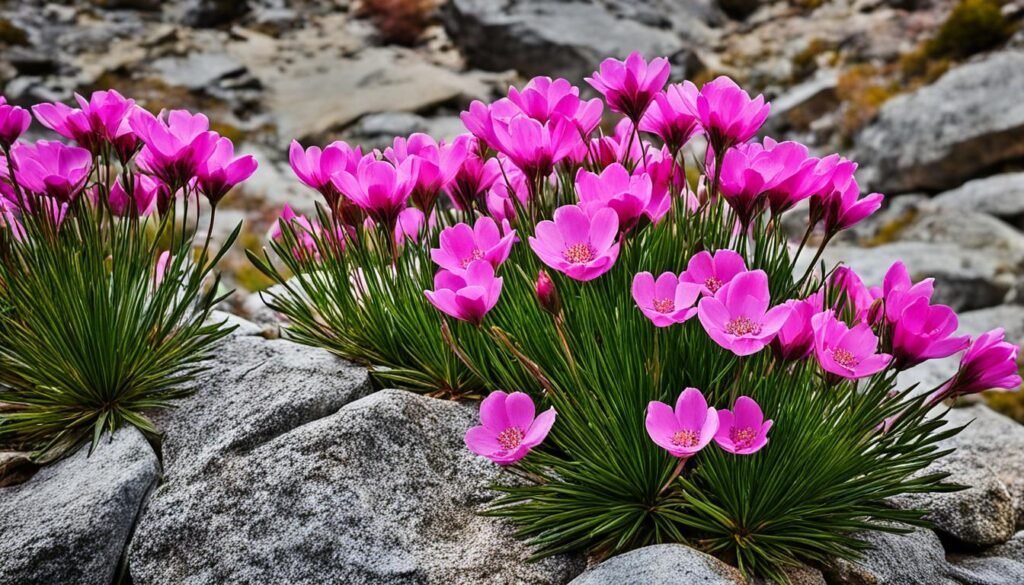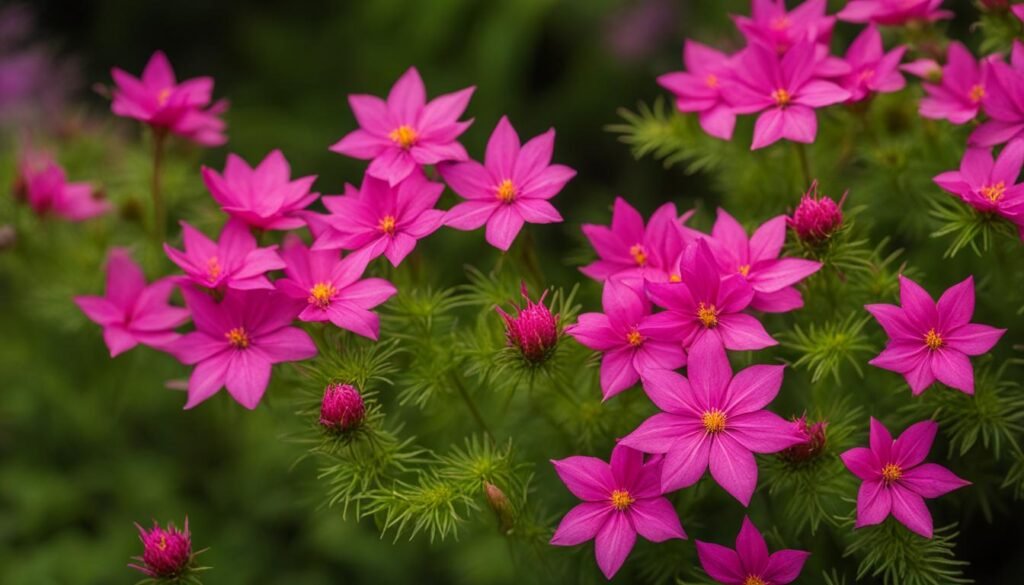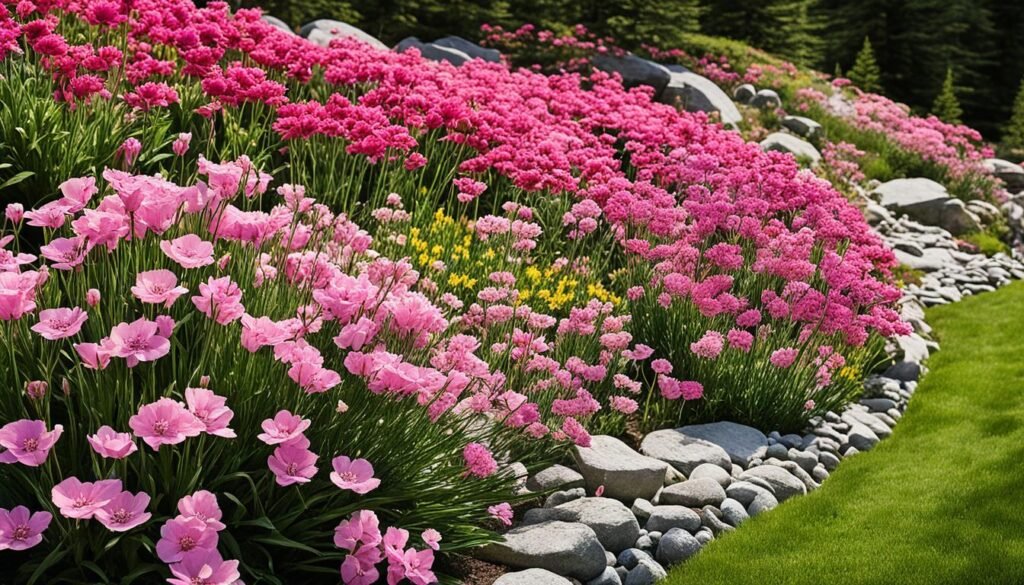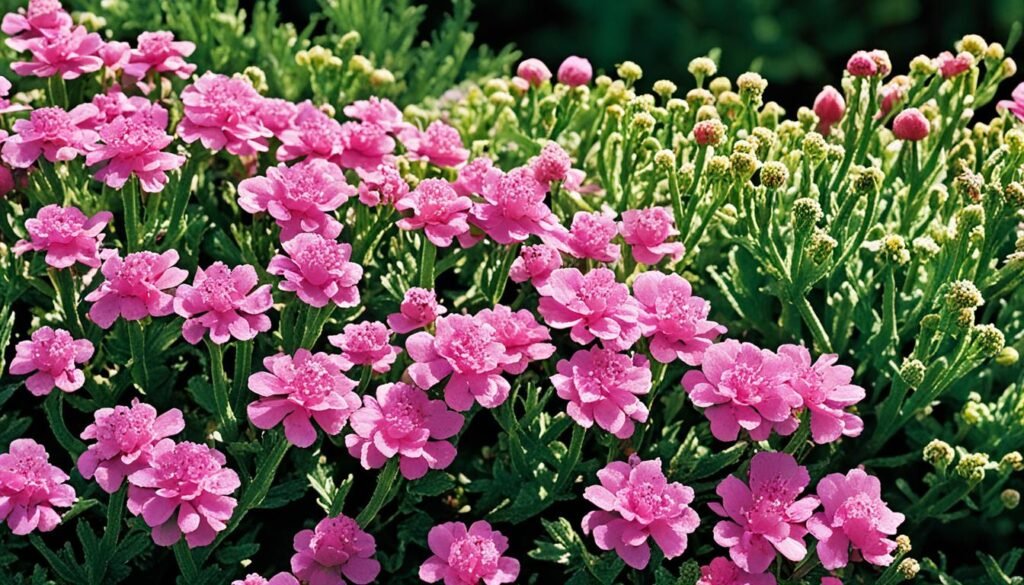As a child, I would spend countless summer afternoons exploring the mountains near my grandparents’ cabin. One particular memory that remains etched in my mind is the sight of delicate, vibrant pink flowers clinging to the rugged terrain. These alpine pink flowers, with their pops of color against the backdrop of rocky outcrops, captured my imagination and sparked a lifelong love for mountain gardens.
Alpine pinks, scientifically known as Dianthus alpinus, are hardy perennials that thrive in mountainous regions. With their compact growth and fragrant, colorful blooms, they bring charm and beauty to any landscape. But it wasn’t until I started my own garden that I truly appreciated the benefits of growing alpine pinks.
Planting these resilient blooms in my garden was like bringing a piece of the mountains back home. The alpine pinks not only added a vibrant burst of color but also attracted butterflies and bees, creating a lively and enchanting atmosphere. Their resilience to cold, drought, heat, and salt made them the perfect choice for my mountain garden.
Whether you have a rocky garden, a gravel bed, or simply want to add a touch of alpine beauty to your landscape, alpine pinks are the ideal choice. In this article, you will learn everything you need to know about growing and caring for these stunning perennials. From cultivation tips to maintenance advice, we will guide you through the process of creating your own vibrant alpine pink garden.
Key Takeaways:
- Alpine pinks, or Dianthus alpinus, are hardy perennials with compact growth and fragrant, vibrant flowers.
- They are resilient to cold, drought, heat, and salt, making them suitable for mountain gardens.
- Alpine pinks attract pollinators like butterflies and bees, adding life and beauty to the garden.
- They are versatile and can be planted in rock gardens, gravel beds, or as colorful accents in any landscape.
- With proper care and maintenance, alpine pinks will thrive and bring color to your mountain garden for years to come.
What Are Alpine Pinks?
Alpine pinks, scientifically known as Dianthus alpinus, are also commonly referred to as rockery pinks. They belong to the carnation family, Caryophyllaceae, and are classified as herbaceous perennials. These compact plants typically reach a height of four to eight inches with a spread of six to 12 inches.
Alpine pinks produce small, dainty flowers in a wide range of vibrant shades. From burgundy and cerise to fuchsia, mauve, pink, scarlet, and white, these blooms add a pop of color to any garden. The flowers are known for their fragrance, reminiscent of traditional carnations. In addition to their vibrant blooms, alpine pinks have fine, grass-like leaves that form dense mats of beautiful, steel-blue foliage.
Characteristics of Alpine Pinks
“Alpine pinks, also known as rockery pinks, are compact herbaceous perennials with vibrant, fragrant flowers and steel-blue foliage.”
| Scientific Name | Common Name | Family | Height | Spread | Flower Colors | Foliage Color |
|---|---|---|---|---|---|---|
| Dianthus alpinus | Alpine pinks | Caryophyllaceae | 4-8 inches | 6-12 inches | Burgundy, cerise, fuchsia, mauve, pink, scarlet, white | Steel-blue |
With their vibrant flowers and compact growth habit, alpine pinks are a beautiful addition to rock gardens, gravel gardens, and other mountain landscapes. Their ability to thrive in various growing conditions makes them a popular choice among gardeners. Whether you’re looking to add a splash of color or a touch of fragrance to your garden, alpine pinks are sure to impress.
Cultivation and History
Alpine pinks, or Dianthus alpinus, are native to Europe and specifically thrive in lime-rich, gritty soils in the eastern Austrian Alps. These stunning flowers are well-suited to their alpine habitat, where they grow in rocky pockets, crevices, and high-altitude grasslands. Thanks to their natural environment, alpine pinks have developed remarkable resilience to extreme conditions.
These plants exhibit impressive cold hardiness, allowing them to withstand harsh mountain winters. They also possess heat resistance, making them adaptable to warmer climates. Additionally, alpine pinks have developed drought tolerance and salt tolerance, enabling them to thrive in challenging environments, including seaside gardens that experience salty winter slush.
Alpine pinks have received the prestigious RHS Award of Garden Merit, further exemplifying their exceptional qualities.
It’s important to distinguish D. alpinus from D. x allwoodii, a hybrid breed of alpine pinks. While both are beautiful in their own right, D. alpinus offers unique characteristics, making it a standout choice for gardeners seeking alpine beauty in their landscapes.

Propagation
In order to propagate alpine pinks (Dianthus alpinus), there are three methods that can be employed: division, seeds, and tip cuttings. Each method has its own advantages and considerations, offering different options for expanding your garden.
Division
Division is a common way to propagate alpine pinks, particularly when the centers of the plants start to die out or every two to four years to maintain healthy growth. The best time to divide the plants is right after flowering. By carefully separating the clumps into smaller sections, each with its own root system, you can create new plants to fill empty spots in your garden or share with fellow gardeners.
Seeds
Seeds are another option for propagating alpine pinks. However, it’s important to note that seeds from commercially available hybrid varieties may not grow true to the characteristics of the parent plant. If you collect seeds from your existing alpine pinks, you can sow them in suitable conditions and see what unique variations arise. This method allows for natural genetic diversity and can be an exciting way to discover new color combinations and traits.
Tip Cuttings
Tip cuttings offer a third method for propagating alpine pinks. This technique involves taking cuttings from the tips of healthy plants between June and September. The cuttings can be rooted in moist soil or water, and once they develop roots, they can be transplanted into larger pots or directly into the garden. This method allows you to create new plants that are genetically identical to the parent plant, preserving specific traits and characteristics.
By utilizing these propagation methods, you can quickly expand your collection of alpine pinks and enjoy their vibrant blooms in various areas of your garden.
How to Grow
Growing alpine pinks (Dianthus alpinus) is a rewarding and relatively straightforward process. By providing the right conditions, you can ensure these beautiful plants thrive in your garden or containers. Here are some key tips to help you grow alpine pinks successfully:
1. Sunlight
Alpine pinks thrive in full sun locations. Make sure to choose a spot in your garden or balcony that receives at least 6 hours of direct sunlight daily. This will promote healthy growth and vibrant blooms.
2. Soil Requirements
Alpine pinks prefer humus-rich soil with a pH range between 6.0 and 7.5. The soil should also be well-draining to prevent waterlogging and root rot. To improve drainage, you can add organic matter such as compost or well-rotted manure. Pro tip: Mixing in some landscape sand or pea gravel can further enhance drainage.
3. Fertilization
Providing adequate nutrients is key to the success of alpine pinks. Before planting, incorporate bone meal into the soil to promote healthy root growth. You can also apply a balanced slow-release fertilizer once a year during the growing season to support overall plant vigor and flower production.
4. Watering
Alpine pinks have moderate water requirements. Aim to provide about one inch of water per week. It’s important to allow the top layer of soil to dry out slightly between waterings to prevent overwatering, which can lead to root rot. Monitor the moisture level of the soil and adjust your watering frequency accordingly.
5. Container Cultivation
If you choose to grow alpine pinks in containers, it’s essential to select a well-draining soil mix. Use a combination of potting soil and moisture-retentive materials, such as perlite or vermiculite, to ensure proper drainage while retaining some moisture. Additionally, make sure containers have drainage holes to prevent waterlogging.

By following these guidelines, you can enjoy the beauty of alpine pinks in your garden or containers. These charming flowers will add vibrancy and fragrance to any outdoor space.
Growing Tips
When it comes to growing alpine pinks (Dianthus alpinus), there are a few key tips to keep in mind to ensure healthy plants and abundant flowering.
1. Full Sun Locations
Alpine pinks thrive in full sun, so it is important to choose a location that receives at least 6 hours of direct sunlight each day. This will promote optimal growth and vibrant blooms.
2. Enriched Soils
Prepare the soil for your alpine pinks by enriching it with organic matter such as compost or well-rotted manure. This will help improve soil fertility and drainage, providing the nutrients the plants need to thrive.
3. Water Requirements
Alpine pinks have moderate water requirements. They prefer consistently moist soil, but be sure not to overwater, as this can lead to root rot. Allow the top inch of soil to dry out between waterings to promote healthy root development.
4. Mulch for Cold Protection
In colder climates, it’s important to provide adequate cold protection for your alpine pinks. Mulching with sharp gravel can help insulate the roots, keeping them cool in the summer and protecting them from cold temperatures in the winter. Additionally, a layer of mulch can help deter pests like slugs and snails.

5. Container Cultivation
If you’re growing alpine pinks in containers, consider using a two-inch layer of pea gravel as mulch to provide additional cold protection. Place the containers in a sheltered spot to shield them from harsh winter weather.
By following these growing tips, you can ensure the health and beauty of your alpine pinks. With their vibrant colors and delicate fragrance, these plants will be a delightful addition to your garden.
Pruning and Maintenance
Pruning and maintenance are essential for the health and vitality of alpine pinks (Dianthus alpinus). By following a few simple practices, you can ensure that your plants thrive and continue to delight with their vibrant blooms.
Division
Regular division of alpine pinks every two to four years or when the centers begin to die off is crucial for their well-being. Dividing the plants helps rejuvenate them and promotes healthy growth. It’s best to divide alpine pinks right after flowering, using a sharp, clean knife to separate the clumps.
Fertilization
Applying slow-release or water-soluble fertilizers to alpine pinks after new growth emerges can greatly enhance their flowering performance. Fertilizers high in phosphorus are particularly beneficial, as they promote robust flower production and overall plant vigor.
Deadheading
Removing spent blooms from alpine pinks through deadheading not only improves their appearance but also encourages a lighter rebloom. Simply pinch or cut off the faded flowers just above a set of healthy leaves to prompt the development of new buds.
Shearing
Shearing alpine pinks after their initial flowering can help maintain a compact and tidy growth habit. Use sharp pruning shears or scissors to trim the plants back by one-third to half their original height. This practice not only promotes a neater appearance but can further stimulate reblooming.
Seed Collection
If you’re interested in propagating alpine pinks, seed collection is an effective method. Wait until late summer, when the seed heads have dried and turned brown. Gently shake or brush the seeds into a container, ensuring you collect them before they scatter naturally.
Winter Preparation
Preparing alpine pinks for winter is essential to protect them from harsh conditions. Clean away any plant debris around the base of the plants to minimize the risk of pest and disease issues. Apply a layer of pea gravel mulch around the plants to provide insulation and prevent moisture buildup, which can lead to root rot. Avoid using heavy mulches that hold excess moisture during the winter months.

By incorporating these maintenance practices into your gardening routine, you can enjoy healthy and thriving alpine pinks year after year. Whether you’re dividing the plants, fertilizing for optimal growth, deadheading spent blooms, shearing for a neat appearance, collecting seeds for propagation, or preparing them for winter, these simple tasks will ensure the longevity and beauty of your alpine pinks.
Cultivars to Select
When it comes to alpine pinks (Dianthus alpinus), there is no shortage of popular cultivars to choose from. These varieties offer unique features and captivating flower displays that can enhance any garden or landscape. Two notable cultivars are Eastern Star and Fire Star, each with its own distinctive qualities.
Eastern Star
A true gem among alpine pinks, Eastern Star, also known as Red Dwarf, showcases exquisite cherry red flowers with deep magenta eyes. The petals are delicately edged with light pink, creating an enchanting contrast. This cultivar releases a sweet cloves fragrance, adding an additional sensory delight to your garden.
Fire Star
If you’re seeking a show-stopping display, Fire Star, also referred to as Devon Xera, is a perfect choice. It boasts profuse fringed flowers in a stunning shade of raspberry red, adorned with a dark crimson eye. The blooms emit a delightful spicy perfume of cloves, infusing the air with an enticing fragrance.
Whether you opt for the captivating Eastern Star or the dazzling Fire Star, these popular cultivars of alpine pinks will bring vibrant colors and alluring scents to your outdoor space.
| Cultivar | Common Name | Flower Color | Eye Color | Margin Color | Fragrance |
|---|---|---|---|---|---|
| Eastern Star | Red Dwarf | Cherry Red | Deep Magenta | Light Pink | Sweet Cloves |
| Fire Star | Devon Xera | Raspberry Red | Dark Crimson | N/A | Spicy Cloves |

Managing Pests and Disease
While alpine pinks (Dianthus alpinus) are generally resistant to pests and diseases, there are still some common issues that may occasionally affect these plants. Pests such as aphids, snails, and slugs can pose a threat to the health of alpine pinks. To ensure the well-being of your plants, it’s important to regularly inspect them and promptly address any signs of infestation.
Prevention:
- Encourage natural predators: Attract beneficial insects like ladybugs, lacewings, and parasitic wasps to your garden to help control aphid populations.
- Practice good garden hygiene: Clean up fallen leaves and other plant debris to minimize hiding places for pests.
- Avoid excessive fertilization: Over-fertilizing can make plants more susceptible to pests and diseases. Follow recommended feeding guidelines.
Treatment:
“Inspect your alpine pinks regularly and take immediate action if you notice any signs of pest infestation. For aphids, consider using insecticidal soap or a strong spray of water to dislodge them from the plants. Slugs and snails can be manually removed or controlled with organic slug pellets or barriers like copper tape around plants.”
It’s also important to provide proper cultural care for your alpine pinks to minimize the risk of diseases. Well-draining soil, appropriate watering practices, and good air circulation can help prevent issues such as root rot and powdery mildew.

| Pest | Symptoms | Prevention | Treatment |
|---|---|---|---|
| Aphids | Curled leaves, stunted growth | Attract beneficial insects, practice good garden hygiene | Insecticidal soap, strong spray of water |
| Slugs and Snails | Holes in leaves, slimy trails | Handpicking, organic slug pellets, copper tape barriers | Manual removal, organic slug pellets |
Best Uses
Alpine pinks, or Dianthus alpinus, are versatile plants that can thrive in various settings. Their compact growth and vibrant blooms make them a great choice for enhancing the beauty of different garden styles and landscapes.
One of the best uses for alpine pinks is in rock gardens. These plants are well-suited for rocky, low-nutrient environments and can beautifully accentuate the natural rock formations. Their dainty flowers and blue-green foliage create a charming contrast against the rugged rocks.
Gravel gardens are also perfect for showcasing the beauty of alpine pinks. The plants’ exquisite blooms stand out against the neutral-toned gravel, creating an eye-catching display. Additionally, their compact size makes them an excellent choice for smaller gravel garden designs.
Mountain landscapes can greatly benefit from the addition of alpine pinks. These plants are native to high-altitude areas and thrive in the alpine habitats. Planting them in mountainous regions can help recreate the natural beauty of their original environment, adding bursts of color to the landscape.
Alpine pinks also make fantastic additions to beds and borders. Their compact growth habit allows them to fit seamlessly into flower beds and help create a layered effect when combined with other plants. The vibrant blooms and fragrant flowers add visual and sensory appeal to any garden design.
Furthermore, alpine pinks can be cultivated in containers, making them versatile options for various gardening spaces. Whether placed on a porch, patio, or balcony, these plants can bring color and fragrance to smaller outdoor areas. Their ability to attract beneficial insects further enhances their value in container gardening.

To summarize, alpine pinks are versatile plants that can be used in rock gardens, gravel gardens, mountain landscapes, beds, borders, and containers. Their ability to thrive in different environments and their vibrant blooms make them a valuable addition to any garden.
Quick Reference Growing Guide
To provide a quick reference for growing alpine pinks, here is a summary of the key points:
- Plant in a full sun location.
- Use humus-rich soil with a pH of 6.0 to 7.5.
- Ensure well-draining soil with organic matter and landscape sand.
- Water deeply, allowing the top of the soil to dry out between waterings.
- Mulch with sharp gravel for winter protection and pest deterrence.
- Prune after flowering for reblooming.
- Divide every two to four years or when the centers die off.
- Provide adequate fertilization and regular maintenance.
- Collect seeds for propagation.
- Prepare plants for winter with proper cleaning and mulching.
Following these guidelines will ensure the successful growth and care of your alpine pinks, providing you with beautiful blooms season after season.
| Aspect | Soil | Watering | Pruning |
|---|---|---|---|
| Full sun | Humus-rich, pH 6.0-7.5 | Allow top of soil to dry out between waterings | Prune after flowering for reblooming |
 | |||
Conclusion
Alpine pinks, scientifically known as Dianthus alpinus, are hardy perennials that bring vibrant blooms and resilient beauty to mountain gardens. With their compact growth, fragrant flowers, and vibrant colors, alpine pinks are a must-have for rock gardens, gravel gardens, and mountain landscapes. These versatile plants are easy to grow and maintain, with excellent resistance to cold, drought, heat, and salt.
One of the many benefits of alpine pinks is their ability to attract pollinators while remaining deer-resistant. Whether planted in a rock garden or used as a charming ground cover, these small plants make a big impact. With proper care and attention, alpine pinks bring an explosion of color, fragrance, and charm to any setting.
Whether you’re considering growing alpine pinks for their stunning flowers, compact form, or resilience in various conditions, these perennials are sure to brighten up your garden. Their vibrant blooms and rich fragrance make them ideal for rock gardens, gravel gardens, and mountain landscapes. Don’t miss out on the beauty and benefits of alpine pinks – start growing and caring for these captivating plants today!
